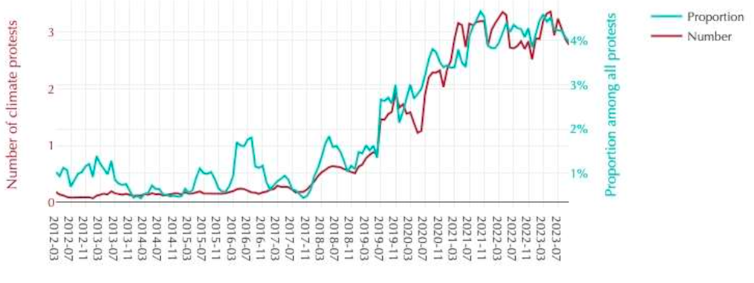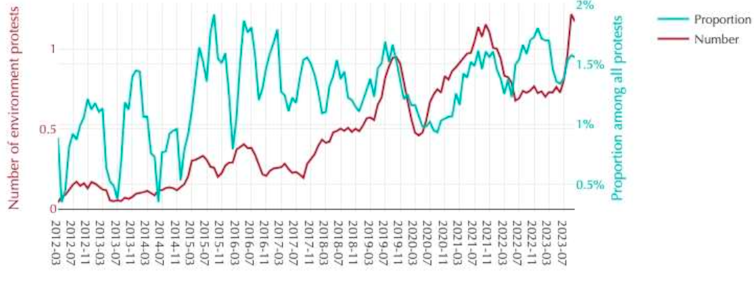
Melnikov Dmitriy/Shutterstock
A team of academic researchers, lawyers and journalists from 16 European countries has exposed a huge lobbying campaign aimed at gutting a proposed EU-wide restriction on the use of “forever chemicals”. This campaign saw significant increases in the lobbying expenditure of major producers of perfluoroalkyl and polyfluoroalkyl substances (PFAS), known as forever chemicals for their persistence in the environment.
This expenditure supported many high-level meetings with European Commission officials, as well as efforts to mobilise other industry players in the lobbying campaign to promote voluntary alternatives and substantial exceptions to this proposed restriction. One result was that the European Chemical Agency’s public consultation on the restriction was buried under a deluge of responses to its proposal.
PFAS are a family of thousands of synthetic chemicals that are implicated in a growing number of illnesses and health complications – ranging from liver damage to compromised immune systems. They share a common characteristic: a carbon-fluorine bond – one of the strongest in organic chemistry – which makes PFAS highly persistent, meaning they can bioaccumulate within plants and animals over time.
The sheer number of PFAS means that restricting them as a class, as is being considered by the EU, is regarded as vital by a growing number of scientists . If this proposed restriction fails and PFAS emissions remain unrestricted, the cost of cleaning up ongoing contamination in Europe is estimated to run to €2 trillion (£1.7 trillion) over the next 20 years – an annual bill of €100 billion.
Without a class restriction, the alternative is a case-by-case approach to assessing toxicity. This would not only be very slow, it would increase the risk of just swapping banned PFAS for other ones that haven’t yet been proven to cause harm – known as “regrettable substitution”.
Historically, banning individual PFAS chemicals has led to their replacement with structurally similar compounds that pose similar or unknown risks. A class-based restriction would reduce the likelihood of such substitutions.
As part of a Europe-wide investigation into PFAS called the Forever Lobbying Project, I have been collaborating with 18 academic researchers and lawyers plus 46 investigative journalists, including Stéphane Horel and Raphaëlle Aubert at French newspaper Le Monde, which coordinated the project. By working together, we can reach a much larger audience across Europe and increase awareness of the costs of PFAS to public health and the environment.
Revelations of the major lobbying campaign and the clean-up costs – the first estimate of its kind for Europe – have come out of this collaboration. Our work has been an inventive combination of investigative journalism and social and applied science methodologies, which aim to extend and underpin existing reporting techniques.

Ian Hayhurst/Shutterstock
In 2023, many members of the current team had previously mapped PFAS contamination across Europe, making “unseen science” available to the public for the first time. This first investigation, which identified over 23,000 confirmed contaminated sites, was hugely influential, strengthening calls for the current class-based, EU-wide restriction.
But resistance from chemical manufacturers quickly proved to be fierce. And it was the realisation among journalists within the consortium that the chemical industry might defeat the proposed class-based restriction that kickstarted the idea for this latest investigation into the lobbying campaign.
The cost of policy failure
Two questions are central to making sense of the lobbying campaign for the public. What would the bill be for cleaning up ongoing PFAS pollution if the campaign is successful? And how had the PFAS manufacturers and plastics industry been able to make so much headway with European officials?
The annual cost estimate of €100 billion was one of several calculated – it relates to ongoing clean-up costs in Europe in the absence of effective restrictions and source control. The process of calculating the costs was overseen by environmental engineer Ali Ling and environmental chemist Hans Peter Arp, who developed a methodology with data journalist Aubert. Together, they advised journalists within the team on which data to look for and actively checked datasets.
The annual cost figure is large – roughly the GDP of Bulgaria – yet represents a conservative estimate, reflecting the difficulties in addressing PFAS decontamination. PFAS chemicals escape most traditional remediation techniques and require highly specialised, energy-intensive technologies to eradicate them. This annual cost will continue as long as PFAS are not phased out and continue to accumulate in the environment.
The lobbying campaign essentially rested on three contentions: that most PFAS were not harmful to health so there was no need for a broad restriction; that there were few practical alternatives to PFAS; and that a broad restriction on their manufacture and use would effectively hollow out the European economy, killing the European green transition.
If the chemical industry were being taken seriously by EU officials, EU policymakers would be more likely to be persuaded by these arguments. So, our consortium decided to look at them more closely and “stress-test” them.
To do this, the team – organised by Horel – adapted approaches used to explore the validity of industry arguments used in tobacco and food policy conflicts. Our results are telling.
The industry association that represents European polymer producers, Plastics Europe, for instance, emphasised the concept of “polymers of low concern” to claim that most fluoropolymers were in fact perfectly safe, or at least highly likely to be safe.
But, as one Le Monde article states: “Plastics Europe declined to share the data, assumptions and methods that underpin its dire predictions.” Plastics Europe also declined interview requests from Le Monde.
Plastics Europe arguably had implied that the concept of polymers of low concern encapsulated criteria developed by the Organisation for Economic Co-operation and Development (OECD). To the casual observer, this association with a respected international policy organisation gave it a measure of validity.
So, we traced the origins of the concept. Yes, there had been an OECD expert group which had “engaged in discussions on criteria for identifying polymers of low concern” between 1993 and 2009. But there had never been enough reliable data for the OECD to commit to the idea as an institution. The OECD confirmed to Horel that “no agreed-upon set of criteria at the OECD level was finalised”.
Other arguments we stress-tested exhibited different weaknesses, but they typically worked to the same effect. Facts and observations were twisted and exaggerated to present a lose-lose or “dystopian” characterisation of the EU proposals – terrible economic losses globally, with no appreciable health or environmental benefits.
As things stand, the EU restriction is finely balanced. Officials within the European Commission have been reported to be “offering reassuring indications to corporate interests about future decision-making”.
By raising important questions about the consequences of not regulating, and highlighting the dubious arguments put forward to justify doing nothing, we hope our latest investigation has shifted the language and focus of public debate. But whether this will displace the current short-termist emphasis on competitiveness and deregulation being pushed by some members of the European Commission remains to be seen.
————————————
This blog is written by Gary Fooks, Professor in Criminology, University of Bristol. This article is republished from The Conversation under a Creative Commons license. Read the original article.

,


